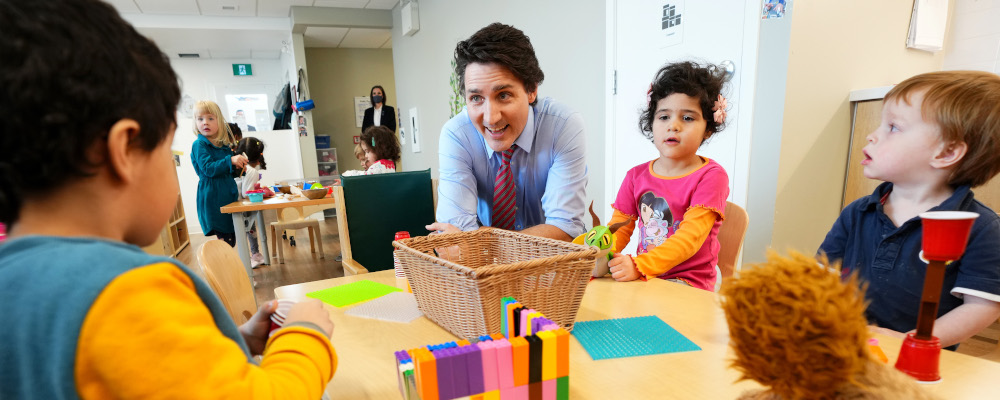As the federal government pushes to pass Bill C-35 to make a national, publicly funded childcare system “permanent,” it has received considerable support from Ontario’s cities. There could be various explanations for this. But a big one is money. Ontario municipalities stand to receive significant new funding (and public employment) as part of the federal scheme.
To recap, in May 2021 the federal budget allocated $27.2 billion to the provinces over five years for the Canada-wide Early Learning and Child Care Plan (CWELCC). All the provinces signed agreements, with Ontario’s allocation ringing in at $13.2 billion. The federal dollars to Ontario are then downloaded to 47 municipal governments for distribution—the only province in Canada to do so.
While every municipality is receiving funding, a look at one municipality allows for a more complete consideration of the details. The Regional Municipality of Peel is part of the 905 region around Toronto, including Brampton, Mississauga, and Caledon. It is one of Ontario’s largest municipal governments. With a population of about 1.5 million people it is larger than Saskatchewan. This includes approximately 87,000 children under age six and about 211,000 children under age 12.
Yet only a minority of these children have access to a licensed childcare space and thus to the possibility of cheaper daycare because only licensed daycare is eligible for subsidies under the federal plan. Peel’s 2023 budget and business plan says the municipality currently provides “funding, advice, and oversight to 191 providers who operate more than 47,000 licensed child care spaces.”
Inside of three years, Peel’s childcare funding is set to increase substantially. The Peel Business Plan and Budget 2023-2026 speaks of the growth. The Early Years and Child Care division projects revenues in 2023 of $398 million. This is, according to the municipal government, about “45 percent higher than 2022 and is expected to grow by half a billion dollars by 2024, making it one of the largest program budgets in Peel.”
One consequence is that the Peel needs to hire staff. A memo dated May 12, 2022 from the municipality’s commissioner of Human Services recommends adding 20 new full-time positions, funded by provincial taxpayers, and that Peel hires a new, full-time bureaucrat “for every 2,000 additional spaces.” While it is not possible to know the salary range for each new hire, by way of example, one Peel job posting for a Specialist, Early Years and Child Care Services, was listed with a salary range of $84,335 to $105,417 annually, plus benefits. This official would “support Service System Manager responsibilities for capacity building; diversity, equity, inclusion; and quality in the early years and child care system.”
Peel’s goal is to create 40,000 new licensed childcare spaces for kids under six in the next four years. If achieved by 2026, this would presumably mean 20 new full-time bureaucrats—for a total of 40 new employees to administer child care. This is in addition to Ontario’s Early Years and Child Care Division, situated within the Ministry of Education, which currently employs nearly 200 civil servants.
That said, the current CWELCC provincial space allocation to Peel region is 7,621 spaces. A provincial official has said that space targets were communicated in December 2022 with a request for feedback from municipalities, which the provincial ministry is currently analyzing.
However these space needs are determined, there’s little evidence that the Peel regional city council is scrutinizing the government’s plan for hiring or spending. When the regional government’s Director of Early Years and Child Care Services presented her division’s budget and business plan to councillors, the toughest question came from Councillor Alvin Tedjo, a former vice president of the Ontario Coalition for Better Childcare—a group founded in 1981 to lobby for a public, not-for-profit childcare system—who “wanted to see if we would be able to hit our targets for 2025.” The answers were far from clear.
Yet the council appears to have moved fairly quickly from any scrutiny to celebration. After the budget presentation, Peel Regional Chair Nando Iannicca gushed about the transformational nature of the funding, worrying about the need for “some sort of ceremony just to acknowledge what was done and the great work the three levels of government have done on this.” Council is obviously bullish on the program’s success.
It’s worth noting that only 51 percent of Peel’s childcare funding allocation from the province is courtesy of the new federal CWELCC plan. Peel spends its budget by distributing money to daycare centres through 12 grant programs of which CWELCC is but one. In an already complex granting system, CWELCC increases the complexity, since it is a significant funding stream, with terms attached to it that are still being decided.

One thing is for certain: increasing federal funding means increasing administrative costs, something section 4.9 of the federal agreement with Ontario recognizes, ensuring administration cannot exceed 10 percent of the funding total. This clause is in every province’s agreement with the federal government. There’s also an Ontario provincial CWELCC funding allocation for administration (for all municipalities combined) that comes to $26 million in 2023, plus a one-time transitional grant, likewise used for administration, to all municipalities of $85 million. Peel’s share is $8.8 million.
Beyond the three layers of government there is a fourth layer: the childcare providers themselves. Just accessing grant monies is itself an administrative burden. Many report spending significant hours weekly applying for grants and replying to both municipal and provincial requests for information. Some report having duplicate inspections from both levels of government. Since only the province has authority to do quality control, municipal visits are redundant.
The upshot is that, as Peel region talks about creating spaces, some providers are pulling back from space expansion. “All talk of opening new sites or expanding or growing is gone,” says Greg Humphreys of Alpha Child Care in Peel. “No one talks about that anymore.” There is the risk that as a municipality such as Peel creates new public spaces, other spaces shutter, as independent providers shelve their expansion plans.
While early childhood educators are getting by on salaries that hover around $20 an hour, there are expanding civil servant positions paying often much more than that. Indeed, Bill C-35, short though the text is, takes care to specify the members of a National Advisory Council on Early Learning and Child Care will be paid, including reimbursements for “travel, living and other expenses incurred.”
The complexity of a national childcare plan comes with millions of dollars for expenditures outside of actual childcare provision. In Ontario, that happens at all three levels of government. The details of that spending deserve much greater scrutiny than they’ve received so far.
Recommended for You

Welcome to the age of great power capitulation: The Hub predicts 2026

A rocky road for Ontario, and an unconventional CUSMA renegotiation: The Hub predicts 2026

Poilievre will survive as CPC leader, and Canada will stay golden in men’s hockey: The Hub predicts 2026

Supply management will be sacrificed to appease Trump, and the Netflix takeover is bad for Hollywood: The Hub predicts 2026



